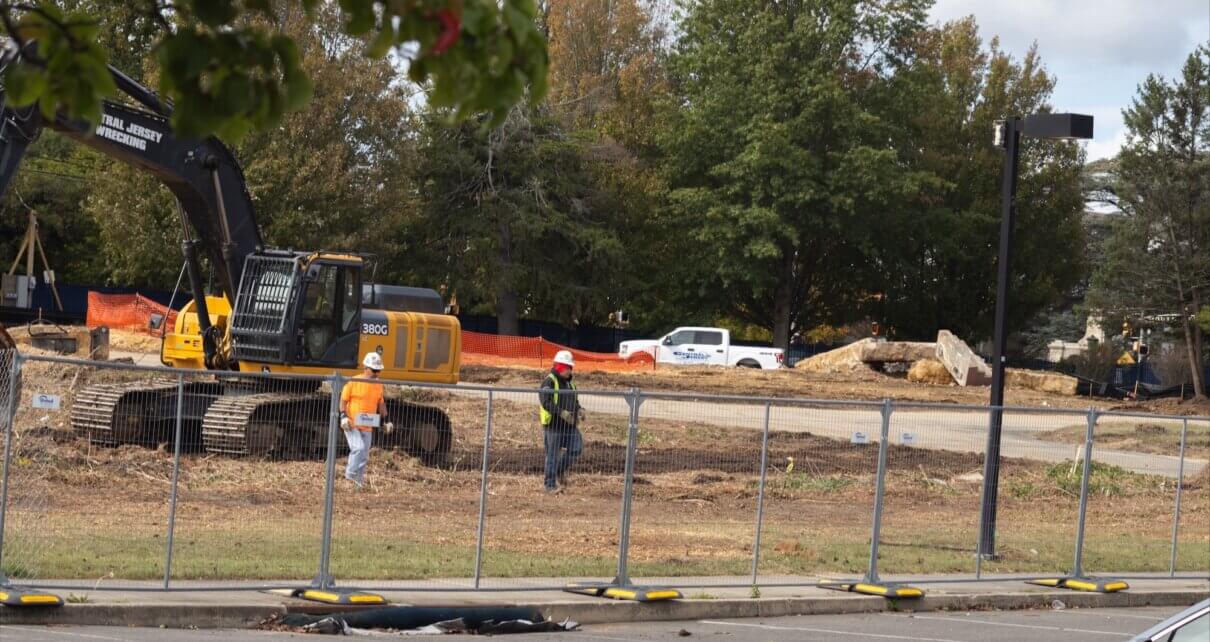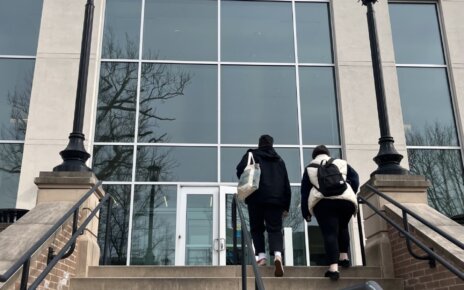In Fall 2023, the Bruce Springsteen Archives and Center for American Music (BSACAM) announced a new, state-of-the-art archival facility, museum, and theater here at Monmouth University. Construction of the new building is officially underway. Over the summer, the police department relocated to the old Alumni House neighboring “So Sweet a Cat” Field, and sections of the Wood’s Theatre parking lot were fenced off in preparation for the demolition of the old police station. On Thursday, Sept. 19, the old police station was demolished, and in the following weeks, the plot of land was cleared of debris and two other buildings adjacent to the property.
There is a lot of buzz on campus about the project, the Archives, and its connection to Monmouth University. Below is an FAQ list to better verse the campus community on BSACAM and its purpose.
What is the Archives?
It all started in 2001 when a group of fans established the Bruce Springsteen Special Collection, which called upon Springsteen fans to donate essential documents from each phase of Springsteen’s career in order to ensure that the historic record would be publicly accessible to all. Since 2011, the Archives has found its home in an old residential home next to Wood’s Theatre. This building is employed by student workers who maintain the Archives filing system and conduct research for scholars who wish to utilize the Archives materials.
Why at Monmouth University?
Before Springsteen was a household name, he would frequent the Monmouth campus in his late teens and early twenties to perform with his band, Steel Mill. The band consisted of Robbin Thompson and future E Street Band members Stevie Van Zandt and Vini Lopez. Springsteen was also a part of the local Asbury Park music scene which bled into Long Branch via the West End area including the InkWell and Garfield Park. With these connections in mind, Bruce Springsteen chose Monmouth University as his official repository in 2017.
Who can use the Archives?
The Archives are open to anyone, including students. Anyone can schedule appointments to visit the Archives by reaching out to its director, Eileen Chapman. The Archives catalog is also available online for researchers to review and request specific items for their visit.
Is it only about regarding Bruce Springsteen?
The Archives, while initially dedicated to Springsteen, also focuses on the New Jersey music scene and includes its rich and extensive music history spanning more than one hundred years. In addition to this, the new building will house spaces dedicated to American music history.
Why the need for a new building?
The current status of the Archives building has reached its maximum capacity and requires a larger space to hold its 35,000+ materials. The current building is more akin to a library and is not properly equipped for the rate of visitors who request to visit, nor is it fit to house the continuous amount of donated materials. Similarly, there is not an explicit space for educational exhibits and lectures that capture the essence of American music, which is one of the main missions of BSACAM. When the new building is complete, it will not only house rotating exhibits focusing on the history of American Music, but also host educational and special events—such as one-on-one talks with artists and scholars as well as intimate performances—in a 250-seat theater.
Who funds this new building?
BSACAM is self-funded through donations from major donors who have dedicated their funds to BSACAM, fundraising events created and presented by BSACAM, and the sale of BSACAM merchandise. Student tuition is not used to fund BSACAM. Once the building is up and running, it will be self-sufficient through visitor contributions and programs.
Where will the new building go?
The new building will be across the parking lot from Wood’s Theatre on the corner of Cedar Avenue and Norwood Avenue.
Is the noise of construction going to be a distraction on campus?
Noise is to be expected with any demolition and construction site, but minimal noise can be heard from the BSACAM site in buildings including Wood’s Theatre and the Guggenheim Memorial Library. Joe Rappolla, Chair of the Music and Theatre Arts department, whose office is in Wood’s, said, “I haven’t heard any complaints from anyone [at Woods], I’ve barely noticed the construction. I’m very excited for the new building and especially the new theater space.”
Kurt Wagner, the University Librarian, whose office resides directly across from the construction site, commented, “I have heard the construction but it wasn’t necessarily disruptive. At its worst, it wouldn’t disrupt any given person working in the main part of the library.” Long Branch noise ordinances permit “excavation, grading, paving, erection, demolition, alteration or repair of any premises, street, building or structure at any time between 7 a.m. and 6 p.m. Monday-Friday and 8 a.m. and 6 p.m. on Saturdays,” and the construction crew has maintained their work within these limitations.
How can Monmouth students benefit from the Archives?
The Archive’s resources complement the variety of course offerings across campus, including but not limited to those provided in history, music, English, education, communication, and business. Students are welcome to reach out with their research inquiries, and the Archives can connect students with unique materials to bolster their research. The Archives also provides several student employment opportunities every semester as well as a Graduate Assistantship as of this fall.
When will the new building be open?
The tentative opening date is April 2026.




